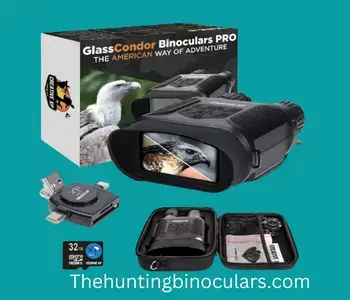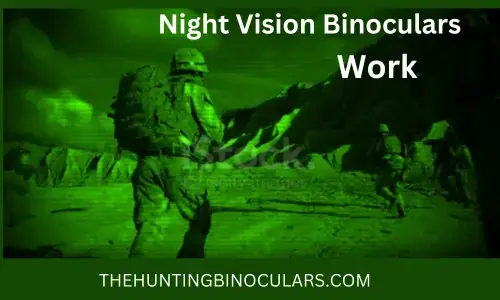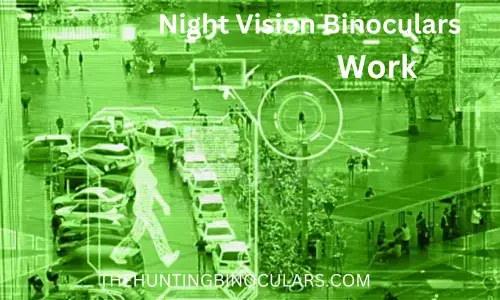
The question is, how to use Night Vision Binoculars? So the answer is very clear, Even on a cloudy, moonless night, a person standing over 200 yards (183 m) away can be seen with the right night-vision binoculars.
when you hear the term “night vision,” the first thing that comes to mind is a scene from a detective or action film in which the protagonist wears a black set of night-vision goggles and searches a dark building for a villain. And perhaps you were curious if those goods perform as advertised? The answer is yes.
Table of Contents
- How to Use Night Vision Binoculars A Detailed Guide
- FAQs
- Can you recommend a suitable magnification for hunting binoculars?
- Which is a superior tool for nighttime observation: binoculars or night vision goggles?
- How many types of binoculars?
- What are the drawbacks of night vision goggles?
- Does cheap night vision work?
- Can night vision binoculars be used in daylight?
- How far can night vision binoculars see?
- What do eye relief binoculars mean?
- What is the optimal magnification for binoculars?
How to Use Night Vision Binoculars A Detailed Guide
Conventional night vision equipment uses optoelectronic image enhancement, which detects minute amounts of infrared light reflected off of objects and then electrically amplifies that light to produce a characteristic glowing green image. This process works by detecting the light reflected off the things.
For simple nighttime tasks like retrieving lost keys when setting up camp, dealing with a tackle box during night fishing, or observing biological activity, low-cost devices of the first generation will suffice. You can use them to locate nocturnal birds and other creatures, though their range is limited and you may only be able to identify them if you get up close. It’s been shown that the quality of Generation 1 gadgets varies widely; in particular, newcomers may be disappointed by very low-priced goods.
Consumers who want more than a new toy that will gather dust in the closet should carefully select well-made equipment. There is little doubt that the extra cost of Generation 2 and 3-night vision instruments are well worth their increased capabilities for conducting in-depth nighttime investigations. The improved field of view, increased light amplification, sharper image, and reduced edge distortions make it easier to locate and identify wildlife.
As these gadgets’ prices drop, more people are discovering the benefits they provide. Technology that allows users to see in the dark, known as “night vision,” is rapidly growing in popularity. They differ significantly from daytime optics and require practice to master. It’s comparable to looking through binoculars at first. Quickly locating and zeroing in on objects in the field of view requires training over time. It takes a systematic approach to fully benefit from a night vision gadget provide. Technology that allows users to see in the dark, known as “night vision,” is rapidly growing in popularity.
They differ significantly from daytime optics and require practice to master. It’s comparable to looking through binoculars at first. Quickly locating and zeroing in on objects in the field of view requires training over time. It takes a systematic approach to fully benefit from a night vision gadget.
Our primary use case for these gadgets is nature observation; good night vision equipment can be invaluable because many animals and birds are nocturnal. Besides the many animals and birds that are exclusively active at night, many diurnal (active predominantly during the day) animals and birds will tolerate significantly closer approaches from viewers in the dark.
Ducks and other waterfowl allow night-vision approaches. However, they will take off quickly as you put on a light. One of the most useful nighttime tools for spotting birds and other wildlife is the reflection of their eyes. The eyes of owls and other nocturnal animals will appear bright and prominent when illuminated by IR light. From forests to seas, camping to boating, night vision paves the way to previously inaccessible and cheap nighttime exploration.

Modifications and controls
Learning the ins and outs of a new device’s interface and becoming adept with its controls is sometimes a requirement when acquiring a modern electronic gadget. You’ll need to break other habits if you’re transitioning from daytime optics. Night vision equipment typically consists of an on/off switch, a focus knob for the eyepiece, and a focus knob for the front lens. While some night vision equipment has a dedicated button for activating the IR illuminator, others have a single switch that toggles between off, main power on, and both primary power and the IR illuminator on before turning itself off. Click on the link to know that how to focus binoculars properly.
Additionally, these toggles regulate two indication lights—a green LED for direct power and a red LED for the infrared light source. A warning about these LEDs is warranted because the IR illuminator beam is invisible to the naked eye and will waste battery life if left on. On some versions, adjustable IR illuminators let you switch between broad and focused illumination.
How does night vision work?
Devices with night vision require a two-step process to achieve focus. Adjust the eyepiece’s concentration first. The simplest method is to set up the eyepiece in a well-lit area without removing the lens cap. Find the point where the image in the eyepiece is sharpest, regardless of whether or not the objective lens is in focus. The distance between the eyepiece and the glowing screen is fixed.
Thus, the stress shouldn’t alter for any individual once it’s been adjusted. However, the focus rings on some models are incredibly sloppy. Focusing on different areas or objects requires adjusting the objective lens after the eyepiece has been set.
Some night vision equipment features an aperture ring as a fourth control option. This ring regulates the quantity of light entering the gadget, analogously to the f-stop of a camera lens. The screen’s brightness and contrast may be fine-tuned with this slider, making it easy to find the optimal viewing conditions.
Enhancing night vision device accessories
The following are examples of extras and accessories:
- Transformers that convert AC to DC
- Eyepiece demist shields are designed to prevent moisture from condensing on the optics during use.
- In the case of magnetic compasses, the compass reading is superimposed on the night vision image. The automated focus and momentary-press switch make it easy to operate, and the light it emits from the compass bearings is bright enough to see in dim conditions.
- Like UV filters in daytime photography, sacrificial windows shield the objective lens from damage. You can save a lot of money by using them instead of buying a new night-vision device.
- Lenses that attach to the device and boost its magnification power
- Beacons are infrared illuminators placed in the landscape instead of being included in the night vision equipment. So that the locations of the viewers are not exposed, they can be utilized to restrict a route or to flood the region with IR.
- Using a camera adapter, you can attach a camera or camcorder to your night vision gadget and film what you see.
- Depending on the model, a goggle kit will comprise a head mount system, an auxiliary lens or lenses, an infrared (IR) illuminator, a camera or camcorder converter, and a carrying case.
- Goggles can be mounted on the head in various ways, the most common being a strap system that wraps around the wearer’s head and secures the goggles in front of their eyes or a clamp system that attaches the goggles to a military-style helmet.
- As was previously noted, IR illuminators are commonly included in night vision systems, but their range is typically relatively low. If your gadget doesn’t come equipped with a light source, or if you need a stronger light to illuminate a wider area, you can purchase an accessory illuminator. Even infrared lamps with a lumen output of 1,000,000 are available.
- Finally, we have standard accessories for any hand-held optical device: cases, batteries, tripods, window mounts, lens caps, etc.

Night Vision Binoculars use and care
Since night vision equipment is electrical, it cannot withstand rigorous treatment. Several versions feature waterproofing and sturdy construction to survive the rigors of everyday outdoor use. Those not designed to withstand wetness (such as those that aren’t waterproof or weather-resistant) may not hold up well in humid environments.
When traveling by air, it is perfectly safe to bring night-vision equipment past airport security checkpoints since the x-ray machines will not damage it. Devices of the First Generation (sometimes called “Generation 1”) can be freely imported and exported. Inquire with the appropriate authorities before taking a device of Generation 2 or later on an international trip (night vision design generations are defined in the previous article).
Avoid using night vision equipment in the daytime or when staring directly at a bright light, as this might cause permanent harm to the devices. As a rule of thumb, you shouldn’t use the unit if it doesn’t have a “gated” tube or is bright enough to see without one. Also, staring directly at bright lights can destroy the screen forever.
Most modern night vision equipment features “cut-off” circuitry that disconnects the power when the gadget is exposed to sunlight. The automated image brightness control found in devices of the second and third generations is another measure to reduce the risk of harm caused by prolonged exposure to intense light.
FAQs
Can you recommend a suitable magnification for hunting binoculars?
If you zoom in any further, the picture will start to blur. It’s up to you to decide if 8x or 10x is better for you. However, 8x are perfect for Eastern hunting situations, while the additional strength of 10x binoculars comes in handy when examining the vast open spaces of the West.
Which is a superior tool for nighttime observation: binoculars or night vision goggles?
Night vision Goggles are fantastic for close-range and mobile use, but binoculars come out on top regarding long-range night vision needs.
How many types of binoculars?
There are three main types of binoculars. In addition, every need can be met with a dedicated set of binoculars:
- Monocular
- Roof-prism binoculars
- porro-prism binoculars
- Which of these two forms of night vision is there?
Industry professionals typically break down night vision into three distinct subcategories: image intensifier night vision, digital night vision devices, and thermal imagers. Image intensifiers for night vision are the most common variety.
What are the drawbacks of night vision goggles?
Night vision has two drawbacks: color and clarity. Vision restricted. Additional electricity is needed.
Does cheap night vision work?
No. Good night vision isn’t cheap. In the more extended version, we get into some more subtleties. A high-quality PVS-14 monocular can cost between $2,000 and $3,400, and a pair of binoculars can cost anywhere from $4,500 to $13,700.
Can night vision binoculars be used in daylight?
Avoid using night vision equipment in the daytime or when staring directly at a bright light, as this might cause permanent harm to the devices.
How far can night vision binoculars see?
In total darkness, this extends your seeing range to around 400 meters (1,300 ft.).
What do eye relief binoculars mean?
The term “eye relief” describes the distance from the lens’s outer surface to the point where the exit pupil is produced (eye point). When viewed with binoculars at the eye point, the entire field of vision is available.
What is the optimal magnification for binoculars?
Binoculars with a magnification of 8-10x are ideal for birding, tracking moving objects, and minimizing shakes when using the optics with relative ease.
Conclusion
You are here to discover, How to use night vision binoculars? Night vision is helpful for private investigators and detectives who are keeping tabs on suspects. Many establishments now use night-vision cameras that are permanently installed. For instance, it can show that the ground was dug up to hide something, even if there are no visible signs.
Law enforcement agencies have utilized technology to unearth hidden contraband such as cash, drugs, and even human remains. In addition, thermal imaging has been used to reveal crucial evidence by showing recent modifications to regions like walls. It’s becoming darker and darker each day, and more and more people are learning about the fascinating world that awaits them when the sun goes down. There is a good chance that night-vision equipment will prove helpful if you spend a lot of time outside camping or hunting; make sure you choose the appropriate model.
